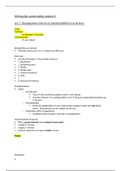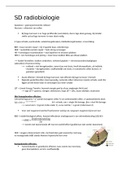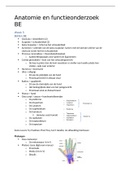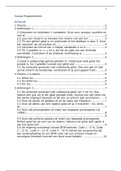AQA A LEVEL PHYSICS
ASTROPHYSICS SECTION
Marlowe Taylor
,Contents
Telescopes (9.1) .............................................................................................................................. 2
Astronomical telescope consisting of two converging lenses (9.1.1) ............................................... 2
Reflecting telescopes (9.1.2)......................................................................................................... 3
Single dish radio telescopes (9.1.3) ............................................................................................... 5
Advantages of larger diameter telescopes (9.1.4) ........................................................................... 7
Classification of stars (9.2) ............................................................................................................. 9
Classification by luminosity (9.2.1)................................................................................................ 9
Absolute magnitude, M (9.2.2) ...................................................................................................... 9
Classification by temperature, black-body radiation (9.2.3) .......................................................... 10
Principles of the use of stellar spectral classes (9.2.4) ................................................................. 11
The Hertzsprung-Russel (HR) diagram (9.2.5)............................................................................... 12
Supernovae, neutron stars and black holes (9.2.6) ....................................................................... 14
Cosmology (9.3) ............................................................................................................................ 16
Doppler effect (9.3.1).................................................................................................................. 16
Hubble’s law (9.3.2) .................................................................................................................... 18
Quasars (9.3.3)........................................................................................................................... 21
Detection of exoplanets (9.3.4) ................................................................................................... 22
, Telescopes (9.1)
- Converging lens – rays parallel to the optic axis are focussed at the principal focus
- Principal focus = the point on the principal axis where parallel light rays meet
- Focal length = distance along the optic axis between the centre of the lens and the principal
focus
1
- Power of a lens = unit = dioptre (D)
focal length
1 1 1 v
- Lens formula (for a converging lens): u + v = f
leads to magnification, M = u
o u = object distance, measured object to lens centre (always positive)
o v = image distance, measured lens centre to image (positive or negative)
o f = focal length of lens (always +ve)
For converging lenses:
Formation of a real image: Formation of a virtual image:
Object more than 1 focal length away from lens Object less than 1 focal length away from lens
u ≥ f image is inverted u ≤ f image is upright
Astronomical telescope consisting of two converging lenses (9.1.1)
- Refracting telescopes use two lenses in the normal adjustment
o Objective lens closer to the object, larger diameter, larger focal length
o Eyepiece lens closer to the eye, smaller diameter, smaller focal length
.
Rays don’t meet so a virtual image is
formed
.
Angular magnification occurs
.
image formed by objective lens lies at
focal point of eyepiece lens. Focal point
of eyepiece lens coincides with focal
point of objective lens
- Angular magnification in normal adjustment
o Light entering the objective enters from different
points on the object being viewed, but for a distant
object like a planet the angle between light from the
top of the object and the light from the middle of the
object is small
o Telescopes make an object appear to be closer than it
actually is – the angle changes while the actual height
of the object remains constant
angular size of image seen through the telescope focal length of objective
o angular magnification = angular size of image seen by unaided eye
= focal length of eyepiece
<
𝑎𝑛𝑔𝑙𝑒 𝑠𝑢𝑏𝑡𝑒𝑛𝑑𝑒𝑑 𝑏𝑦 𝑖𝑚𝑎𝑔𝑒 𝑎𝑡 𝑒𝑦𝑒 𝑓𝑜𝑏𝑗𝑒𝑐𝑡𝑖𝑣𝑒
- 𝑀 = 𝑎𝑛𝑔𝑙𝑒 𝑠𝑢𝑏𝑡𝑒𝑛𝑑𝑒𝑑 𝑏𝑦 𝑜𝑏𝑗𝑒𝑐𝑡 𝑎𝑡 𝑢𝑛𝑎𝑖𝑑𝑒𝑑 𝑒𝑦𝑒 = 𝑓𝑒𝑦𝑒𝑝𝑖𝑒𝑐𝑒
Length of telescope = 𝑓𝑜 + 𝑓𝑒
ASTROPHYSICS SECTION
Marlowe Taylor
,Contents
Telescopes (9.1) .............................................................................................................................. 2
Astronomical telescope consisting of two converging lenses (9.1.1) ............................................... 2
Reflecting telescopes (9.1.2)......................................................................................................... 3
Single dish radio telescopes (9.1.3) ............................................................................................... 5
Advantages of larger diameter telescopes (9.1.4) ........................................................................... 7
Classification of stars (9.2) ............................................................................................................. 9
Classification by luminosity (9.2.1)................................................................................................ 9
Absolute magnitude, M (9.2.2) ...................................................................................................... 9
Classification by temperature, black-body radiation (9.2.3) .......................................................... 10
Principles of the use of stellar spectral classes (9.2.4) ................................................................. 11
The Hertzsprung-Russel (HR) diagram (9.2.5)............................................................................... 12
Supernovae, neutron stars and black holes (9.2.6) ....................................................................... 14
Cosmology (9.3) ............................................................................................................................ 16
Doppler effect (9.3.1).................................................................................................................. 16
Hubble’s law (9.3.2) .................................................................................................................... 18
Quasars (9.3.3)........................................................................................................................... 21
Detection of exoplanets (9.3.4) ................................................................................................... 22
, Telescopes (9.1)
- Converging lens – rays parallel to the optic axis are focussed at the principal focus
- Principal focus = the point on the principal axis where parallel light rays meet
- Focal length = distance along the optic axis between the centre of the lens and the principal
focus
1
- Power of a lens = unit = dioptre (D)
focal length
1 1 1 v
- Lens formula (for a converging lens): u + v = f
leads to magnification, M = u
o u = object distance, measured object to lens centre (always positive)
o v = image distance, measured lens centre to image (positive or negative)
o f = focal length of lens (always +ve)
For converging lenses:
Formation of a real image: Formation of a virtual image:
Object more than 1 focal length away from lens Object less than 1 focal length away from lens
u ≥ f image is inverted u ≤ f image is upright
Astronomical telescope consisting of two converging lenses (9.1.1)
- Refracting telescopes use two lenses in the normal adjustment
o Objective lens closer to the object, larger diameter, larger focal length
o Eyepiece lens closer to the eye, smaller diameter, smaller focal length
.
Rays don’t meet so a virtual image is
formed
.
Angular magnification occurs
.
image formed by objective lens lies at
focal point of eyepiece lens. Focal point
of eyepiece lens coincides with focal
point of objective lens
- Angular magnification in normal adjustment
o Light entering the objective enters from different
points on the object being viewed, but for a distant
object like a planet the angle between light from the
top of the object and the light from the middle of the
object is small
o Telescopes make an object appear to be closer than it
actually is – the angle changes while the actual height
of the object remains constant
angular size of image seen through the telescope focal length of objective
o angular magnification = angular size of image seen by unaided eye
= focal length of eyepiece
<
𝑎𝑛𝑔𝑙𝑒 𝑠𝑢𝑏𝑡𝑒𝑛𝑑𝑒𝑑 𝑏𝑦 𝑖𝑚𝑎𝑔𝑒 𝑎𝑡 𝑒𝑦𝑒 𝑓𝑜𝑏𝑗𝑒𝑐𝑡𝑖𝑣𝑒
- 𝑀 = 𝑎𝑛𝑔𝑙𝑒 𝑠𝑢𝑏𝑡𝑒𝑛𝑑𝑒𝑑 𝑏𝑦 𝑜𝑏𝑗𝑒𝑐𝑡 𝑎𝑡 𝑢𝑛𝑎𝑖𝑑𝑒𝑑 𝑒𝑦𝑒 = 𝑓𝑒𝑦𝑒𝑝𝑖𝑒𝑐𝑒
Length of telescope = 𝑓𝑜 + 𝑓𝑒








